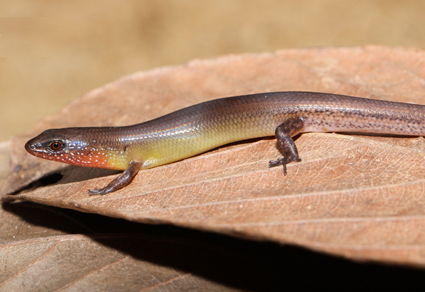Abstract
Lankascincus fallax is an endemic, but widespread species of skink distributed throughout Sri Lanka, including all bioclimatic zones (elevations from 0 to 1,200 m a.s.l.). After thoroughly comparing morphology and morphometry between populations in different bioclimatic zones, we recognize it as a single morphospecies. We revise the systematics of Lankascincus fallax based on molecular and morphological data providing a comprehensive re-description of the adult syntype collected from either Ratnapura or Trinkomalee (sic), Sri Lanka. We provide the first-ever constructed phylogeny of Lankascincus representing five species (out of nine) based on GenBank data. In addition, we examined all the type specimens of the two synonymized species, Sphenomorphus rufogulus and Lankascincus deraniyagalae. We also provide a comprehensive discussion on the distribution of L. fallax.
References
- Amarasinghe, A.A.T., Danushka, A.D., Kanishka, A.S., Campbell, P., Ineich, I., Hallermann, J. & Pauwels, O.G. (2022a) Lygosoma megalops Annandale, 1906 (Squamata, Scincidae): a junior synonym of Lankascincus fallax (Peters, 1860). Bionomina, 26 (1), 50–58.
- Amarasinghe, A.A.T., Ganesh, S.R., Mirza, Z., Campbell, P.D., Pauwels, O.G., Schweiger, S., Kupfer, A., Patel, H., Karunarathna, S., Deuti, K., Ineich, I., Hallermann, J., Abinawanto, A. & Supriatna, J. (2022b) The delusion of stripes: A century-old mystery of five-lined sun skinks (Reptilia: Scincidae: Eutropis) of Peninsular India elucidated. Zoologischer Anzeiger, 296, 71–90. https://doi.org/10.1016/j.jcz.2021.11.004
- Annandale, A. (1906) New and interesting lizards in Colombo Museum. Spolia Zeylanica, 3, 189–192.
- Batuwita, S. (2019) A review of the endemic genus Lankascincus (Reptilia: Scincidae: Lygosominae) from Sri Lanka. Bulletin of the Museum of Comparative Zoology, 162 (3), 211–262. https://doi.org/10.3099/MCZ38.1
- Chan, K.O. & Grismer, L.L. (2022) GroupStruct: An R Package for Allometric Size Correction. Zootaxa, 5124 (4), 471–482. https://doi.org/10.11646/zootaxa.5124.4.4
- Danushka, D., Kanishka, S., Hallermann, J., Campbell, P., Ineich, I., Pauwels, O.G. & Amarasinghe, A.A.T. (2022) Taxonomy, distribution, and conservation of Lankascincus dorsicatenatus (Deraniyagala, 1953) (Reptilia: Scincidae) with the designation of a neotype. Russian Journal of Herpetology, 29 (6), 355–363. https://doi.org/10.30906/1026-2296-2022-29-6-355-363
- Deraniyagala, P.E.P. (1953) A colored atlas of some vertebrates from Ceylon. Tetrapod Reptilia. Vol. 2. The Ceylon Government Press, Colombo, 100 pp.
- Greer, A. (1991) Lankascincus, a new genus of skink lizards from Sri Lanka, with description of three new species. Journal of Herpetology, 25 (1), 59–64. https://doi.org/10.2307/1564795
- IUCN [International Union for Conservation of Nature] Standards & Petitions Subcommittee (2019) Guidelines for Using the IUCN Red List Categories and Criteria. Version 14. Prepared by the Standards and Petitions Subcommittee. IUCN, Gland. [unknown pagination]
- Jayamanna, J.M.A.I.K., de Silva, A.& Ukuwela, K.D.B. (2019) Investigation of throat color polymorphism in relation to sex and body size of the litter skink. Lankascincus Fallax. Rajarata International Research Conference, Faculty of Applied Sciences, RIRC 2019, NSM 48.
- Kanishka, A.S., Danushka, A.D. & Amarasinghe, A.A.T. (2020) A new species of Lankascincus Greer, 1991 (Reptilia: Scincidae) with an overview of the L. gansi group. Taprobanica, 9 (1), 103–119. https://doi.org/10.47605/tapro.v9i1.225
- Karunarathna, D.M.S.S. & Amarasinghe, A.A.T. (2010) Reptile diversity of a fragmented lowland rain forest patch in Kukulugala, Ratnapura District, Sri Lanka. Taprobanica, 2 (2), 86–94. https://doi.org/10.47605/tapro.v2i2.31
- Karunarathna, D.M.S.S. & Amarasinghe, A.A.T. (2012) Reptile diversity in Beraliya Mukalana proposed Forest Reserve, Galle District, Sri Lanka. Taprobanica, 4 (1), 20–26. https://doi.org/10.47605/tapro.v4i1.61
- Karunarathna, D.M.S.S., Henkanaththegedara, S.M., Amarasinghe, A.A.T. & de Silva, A. (2013) Impact of vehicular traffic on herpetofaunal mortality in a savannah forest, Eastern Sri Lanka. Taprobanica, 5 (2), 111–119. https://doi.org/10.47605/tapro.v5i2.106
- Kelaart, E.F. (1854) Descriptions of new Ceylon reptiles. Vol. 2. The Annals and Magazine of Natural History, 1854, 407–408. https://doi.org/10.1080/03745485709496363
- Kumar, S., Stecher, G., Li, M., Knyaz, C. & Tamura, K. (2018) MEGA X: molecular evolutionary genetics analysis across computing platforms. Molecular Biology and Evolution, 35 (6), 1547. https://doi.org/10.1093/molbev/msy096
- Lleonart, J., Salat, J. & Torres, G.J. (2000) Removing allometric effects of body size in morphological analysis. Journal of Theoretical Biology, 205, 85–93. https://doi.org/10.1006/jtbi.2000.2043
- Minh, B., Schmidt, H., Chernomor, O., Schrempf, D., Woodhams, M., von Haeseler, A. & Lanfear, R. (2020) IQ-TREE 2: New models and efficient methods for phylogenetic inference in the genomic era. Molecular Biology and Evolution, 37, 1530–1534. https://doi.org/10.1093/molbev/msaa015
- Peters, W.C.H. (1860) Über einige interessante Amphibien, welche von dem durch seine zoologischen Schriften rühmlichst bekannten österreichischen Naturforscher Professor Schmarda während seiner auf mehrere Welttheile ausgedehnten, besonders auf wirbellose Thiere gerichtet. Monatsberichte der Königlichen Akademie der Wissenschaften zu Berlin, 1860, 182–186.
- Rambaut, A. (2014) FigTree Version 1.4.2. University of Edinburgh, Edinburgh. Available from: http://tree.bio.ed.ac.uk/software/figtree/ (accessed 12 February 2024)
- R Core Team (2021) R: A language and environment for statistical computing. Version 4.0.4. R Foundation for Statistical Computing, Vienna. Available from: https://www.R-project.org/ (accessed 12 February 2024)
- Sabaj, M.H. (2020) Codes for Natural History Collections in Ichthyology and Herpetology. Copeia, 108 (3), 593–669. https://doi.org/10.1643/ASIHCODONS2020
- Somaweera, R. & Somaweera, N. (2009) Lizards of Sri Lanka: A color guide with field keys. Chimaira, Frankfurt, 304 pp.
- Taylor, E.H. (1950) Ceylonese lizards of the family Scincidae. University of Kansas Science Bulletin 33 (2), 481–518. https://doi.org/10.5962/bhl.part.16133
- Thompson, J.D., Gibson, T.J. & Higgins, D.G. (2003) Multiple sequence alignment using ClustalW and ClustalX. Current protocols in bioinformatics, 1, 2–3. https://doi.org/10.1002/0471250953.bi0203s00
- Ukuwela, K.D.B. (2009) Life history traits of three Sri Lankan Scincidae, with special reference to the reproductive seasonality of Lankascincus fallax. Hamadryad, 34 (1), 171–174.
- Wickramassinghe, L.J.M., Rodrigo, R., Dayawansa, N. & Jayantha, U.L.D. (2007) Two new species of Lankascincus (Squamata: Scincidae) from Sripada Sanctuary (Peak Wilderness), in Sri Lanka. Zootaxa, 1612 (1), 1–24. https://doi.org/10.11646/zootaxa.1612.1.1
- Wickramasinghe, L.J.M., Vidanapathirana, D.R. & Wickramasinghe, N. (2020) A new species of Lankascincus Greer, 1991 (Reptilia: Scincidae) from the Rakwana hills of Sri Lanka. Taprobanica, 9, 23–30. https://doi.org/10.47605/tapro.v9i1.218
- Zar, J.H. (2010) Biostatistical Analysis. 5th Edition. Prentice Hall Inc., Pearson, New Jersey, 944 pp.


